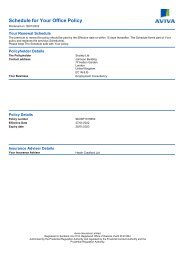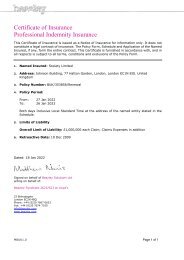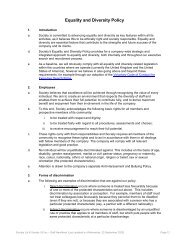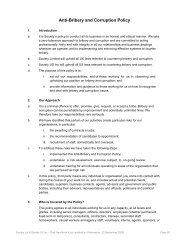Anti-Harassment and Bullying Policy
Create successful ePaper yourself
Turn your PDF publications into a flip-book with our unique Google optimized e-Paper software.
<strong>Anti</strong>-<strong>Harassment</strong> <strong>and</strong> <strong>Bullying</strong> <strong>Policy</strong><br />
1. Introduction<br />
a. The company is committed to creating a harmonious working environment which is free<br />
from harassment, including discrimination, victimisation <strong>and</strong> bullying, <strong>and</strong> which protects<br />
the dignity of all employees irrespective of their gender, sexual orientation, marital or civil<br />
partner status, age, racial or ethnic background, nationality, religion or belief, or disabled<br />
status. <strong>Harassment</strong> is offensive <strong>and</strong> prejudicial to a productive working environment. It is<br />
indicative of a lack of respect for the person harassed, undermines his or her position <strong>and</strong><br />
may have a negative impact upon health, job performance <strong>and</strong> sense of personal<br />
security.<br />
b. The company regards harassment, on any of the grounds listed above, as a most serious<br />
matter. Such behaviour constitutes discrimination <strong>and</strong> is unlawful under the equality<br />
legislation. <strong>Harassment</strong> may also be a civil offence <strong>and</strong> a criminal offence, <strong>and</strong> it may<br />
contravene health <strong>and</strong> safety legislation. All staff should take the time to ensure they<br />
underst<strong>and</strong> what types of behaviour are unacceptable under this policy.<br />
c. Everyone must comply with the policy <strong>and</strong> employees should ensure that their behaviour<br />
at all times does not cause offence or constitute harassment. Formal complaints will be<br />
investigated <strong>and</strong> in cases where the complaint is substantiated, appropriate disciplinary<br />
action, including dismissal, will be taken against the person or persons responsible.<br />
Harassers, their supervisors <strong>and</strong> their managers may all be held personally liable in the<br />
event of any legal proceedings.<br />
2. Definition of <strong>Harassment</strong><br />
a. Personal harassment takes many forms. It is unwanted conduct related to one of the<br />
grounds set out above which has the purpose or effect of violating a person’s dignity or<br />
creating an intimidating, hostile, degrading, or humiliating environment for him/her. It can<br />
be an isolated act such as a wilful comment or gesture, or it can take the form of repeated<br />
behaviour against a person.<br />
b. A person may be harassed even if he/she is not the intended “target”. For example, a<br />
person may be harassed by racist jokes about a different ethnic group.<br />
c. Sexual harassment is unwanted conduct of a sexual nature which has the purpose or<br />
effect of violating a person’s dignity or creating an intimidating, hostile, degrading, or<br />
humiliating environment for him/her.<br />
d. It is also harassment to treat a person less favourably because he/she has submitted to<br />
or rejected previous unwanted conduct of a sexual nature (or conduct related to gender<br />
reassignment or sex).<br />
e. Appendix A at the end of this document outlines some examples of personal harassment.<br />
Some, if occurring only once, may cause only mild irritation but if repeated become<br />
harassing. Other examples are clearly harassment even if they occur only once. All of<br />
them are inappropriate. The list is neither exclusive nor exhaustive <strong>and</strong> other forms of<br />
behaviour may be regarded as harassment, discrimination, victimisation or bullying.<br />
3. Definition of <strong>Bullying</strong><br />
a. <strong>Bullying</strong> is offensive, intimidating, malicious or insulting behaviour involving the misuse of<br />
power that can make a person feel vulnerable, upset, humiliated, undermined or<br />
threatened. Power does not always mean being in a position of authority, but can include<br />
both personal strength <strong>and</strong> power to coerce through fear or intimidation.<br />
Society Ltd & Society US Inc – Staff H<strong>and</strong>book (Last updated on Wednesday, 23 September 2020) Page 15
. Examples of bullying <strong>and</strong> intimidation might be:<br />
i. physical conduct ranging from the invasion of personal space to serious assault;<br />
ii.<br />
iii.<br />
iv.<br />
verbal, written <strong>and</strong> email harassment through derogatory remarks, jokes, insults,<br />
offensive language, gossip <strong>and</strong> sl<strong>and</strong>er;<br />
open aggression, threats <strong>and</strong>/or shouting;<br />
deliberately setting objectives with unreasonable deadlines or changing<br />
objectives unfairly;<br />
v. intrusion by pestering, spying, following, stalking etc;<br />
vi.<br />
vii.<br />
viii.<br />
ix.<br />
unfair allocation of work <strong>and</strong> responsibilities;<br />
behaviour which makes direct or indirect reference to disability or impairment <strong>and</strong><br />
this causes discomfort, patronises, insults or offends people with a physical,<br />
sensory or mental disability;<br />
treating someone adversely because they have or it is suspected/believed that<br />
they have HIV/AIDS;<br />
repeated gibes in reference to personal traits or appearances, invasion of<br />
privacy, or practical jokes causing physical or psychological distress;<br />
x. persistent pressure to become involved in anti-social or unlawful behaviour;<br />
xi.<br />
repeated statements to an individual or third parties which demean an individual’s<br />
professional status <strong>and</strong> performance.<br />
4. Dealing with <strong>Harassment</strong> <strong>and</strong> <strong>Bullying</strong><br />
a. Anyone experiencing harassment should not wait until things become intolerable.<br />
Sometimes the person may not realise that his or her behaviour is unwanted or<br />
unacceptable <strong>and</strong> in such cases the misunderst<strong>and</strong>ings can be resolved quickly.<br />
b. It is helpful to make a note of the time, place <strong>and</strong> nature of any specific incidents <strong>and</strong><br />
attempts to discuss them. This will provide useful information in following these<br />
procedures.<br />
5. Informal Procedure<br />
a. If possible, the individual experiencing harassment should state clearly to the person<br />
concerned that his or her behaviour is unacceptable <strong>and</strong> should cease. In some<br />
circumstances the individual might prefer to write a letter to the person concerned which<br />
should be dated <strong>and</strong> signed, <strong>and</strong> a copy kept as this may be needed as evidence should<br />
the harassment, victimisation or bullying continue or subsequently recur.<br />
b. If the individual does not feel able to talk or write to the person concerned or if the<br />
harassment does not stop, they may wish to discuss the matter with a colleague or with<br />
their supervisor or manager <strong>and</strong> ask them to approach the person concerned on their<br />
behalf.<br />
6. Formal Procedure<br />
a. At any time, whether or not informal steps have been taken, an employee who feels that<br />
he or she or others have been harassed in a way that breaches this policy can raise the<br />
matter with their supervisor or manager, either verbally or in writing, who will deal with it<br />
accordingly. Thereafter, the matter will be dealt with as follows:<br />
i. The appropriate manager will conduct an investigation into the case as soon as<br />
possible to establish whether there is a need to take disciplinary action. The<br />
manager will inform the person against whom the complaint is made of the nature<br />
Society Ltd & Society US Inc – Staff H<strong>and</strong>book (Last updated on Wednesday, 23 September 2020) Page 16
ii.<br />
iii.<br />
iv.<br />
of the complaint <strong>and</strong> that the matter is being investigated formally.<br />
The appropriate manager will arrange a meeting with the employee who has<br />
made the complaint, usually within one week, so that he/she can explain the<br />
reasons for the complaint. The employee has the right to be accompanied by a<br />
colleague or trade union representative of his/her choice, who must respect the<br />
confidentiality of the investigation.<br />
It may be necessary to interview witnesses to any of the incidents mentioned in<br />
the complaint. If so, the importance of confidentiality will be emphasised to them.<br />
If it is found that harassment or bullying has occurred, prompt action will be taken<br />
to address it. Where the harasser or bully is an employee, the matter will be<br />
dealt with as a case of possible misconduct/gross misconduct under the<br />
company’s Disciplinary Procedure. Where the harasser or bully is a third party,<br />
appropriate action will be taken.<br />
v. If the complaint is not upheld, the manager will determine appropriate methods of<br />
resolving the issue following discussion with both parties.<br />
vi.<br />
vii.<br />
viii.<br />
ix.<br />
Both parties will be informed of the decision as soon as possible following the<br />
conclusion of the investigation. The employee who has made the complaint may<br />
not be provided with details of any disciplinary action taken against the individual<br />
concerned, as this is confidential between the company <strong>and</strong> individual<br />
employees.<br />
Malicious allegations will be regarded as disciplinary offences.<br />
If the employee is not satisfied with the outcome of the investigation, he/she has<br />
the right to appeal the decision within one week of being notified of the outcome.<br />
Written grounds of appeal should be submitted to the Directors, who may<br />
nominate another manager to hear the appeal. Where practicable, this will be a<br />
manager senior to the manager who originally considered the complaint.<br />
x. The person hearing the appeal will meet the employee to discuss his/her appeal,<br />
usually within one week. The employee may be accompanied by a colleague or<br />
trade union official of his/her choice. The company will endeavour to notify the<br />
employee of the outcome of the appeal within one week of the meeting.<br />
xi.<br />
This is the final stage of the formal procedure <strong>and</strong> there is no further right of<br />
appeal.<br />
7. Confidentiality<br />
a. All complaints will be treated with due regard for confidentiality.<br />
b. Information about a complaint by or about an employee may be placed on his/her HR file,<br />
along with a record of the outcome <strong>and</strong> any notes or other documents compiled during<br />
the process.<br />
c. Breach of confidentiality may give rise to disciplinary action under the Disciplinary<br />
Procedure.<br />
8. Protection for those Making Complaints or Assisting with an Investigation<br />
a. If an employee makes a complaint, or participates in good faith in any investigation<br />
conducted under this policy, he/she will be protected from any form of intimidation or<br />
victimisation as a result of his/her involvement.<br />
b. If an employee consider that he/she has been subjected to any such intimidation or<br />
victimisation, he/she should seek support from the Managing Director. He/she may also<br />
raise a complaint in writing under this procedure or the Grievance Procedure.<br />
Society Ltd & Society US Inc – Staff H<strong>and</strong>book (Last updated on Wednesday, 23 September 2020) Page 17

















